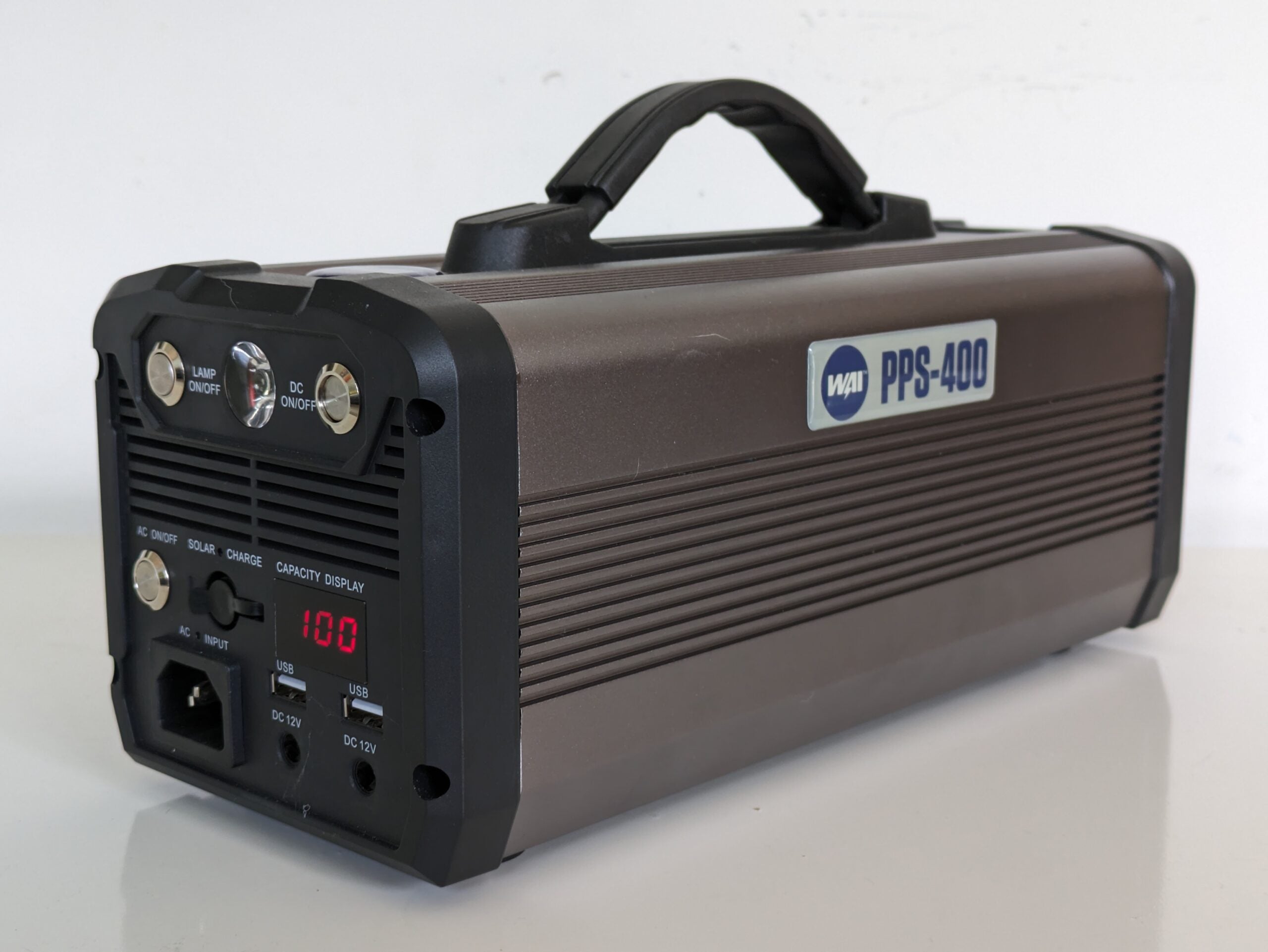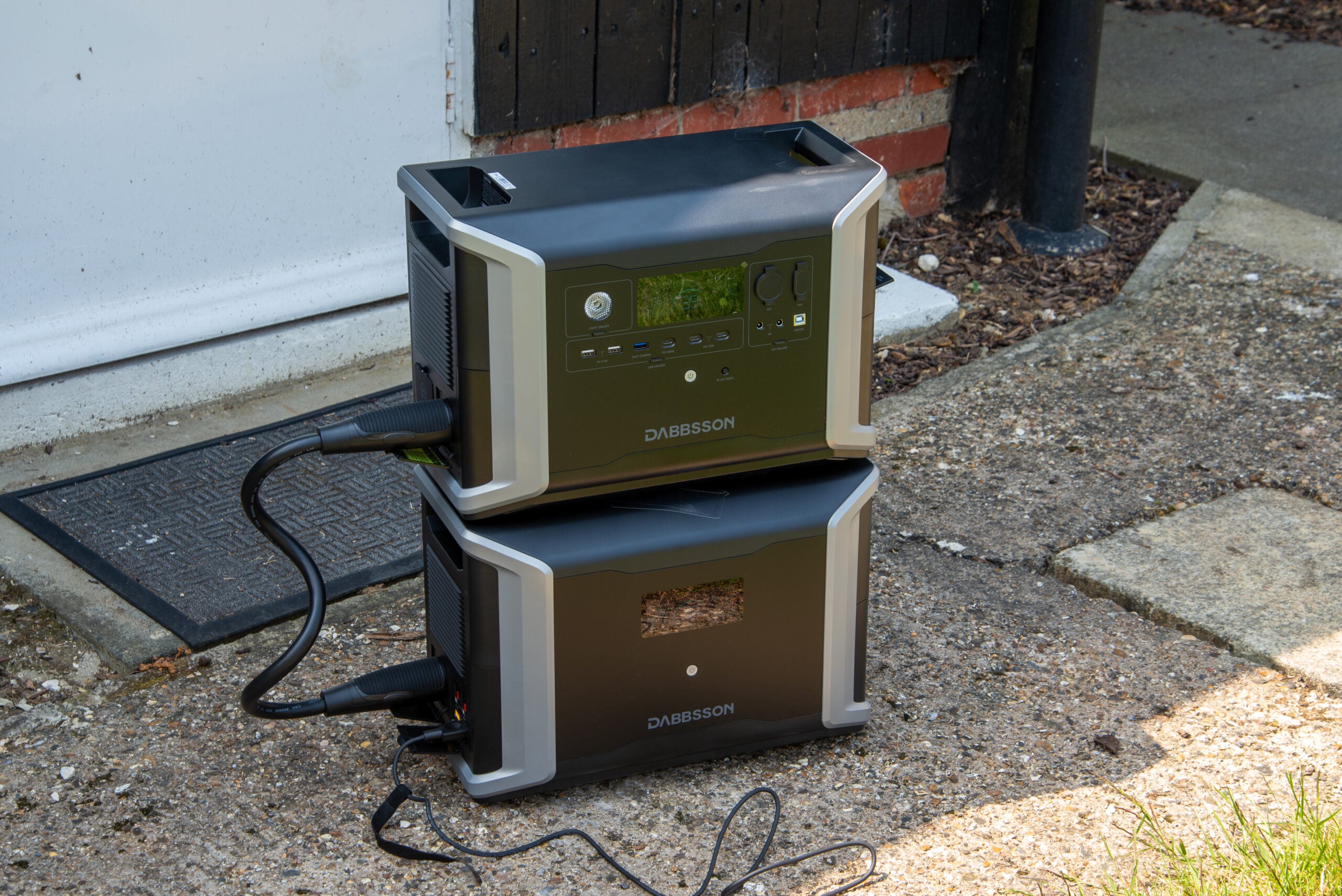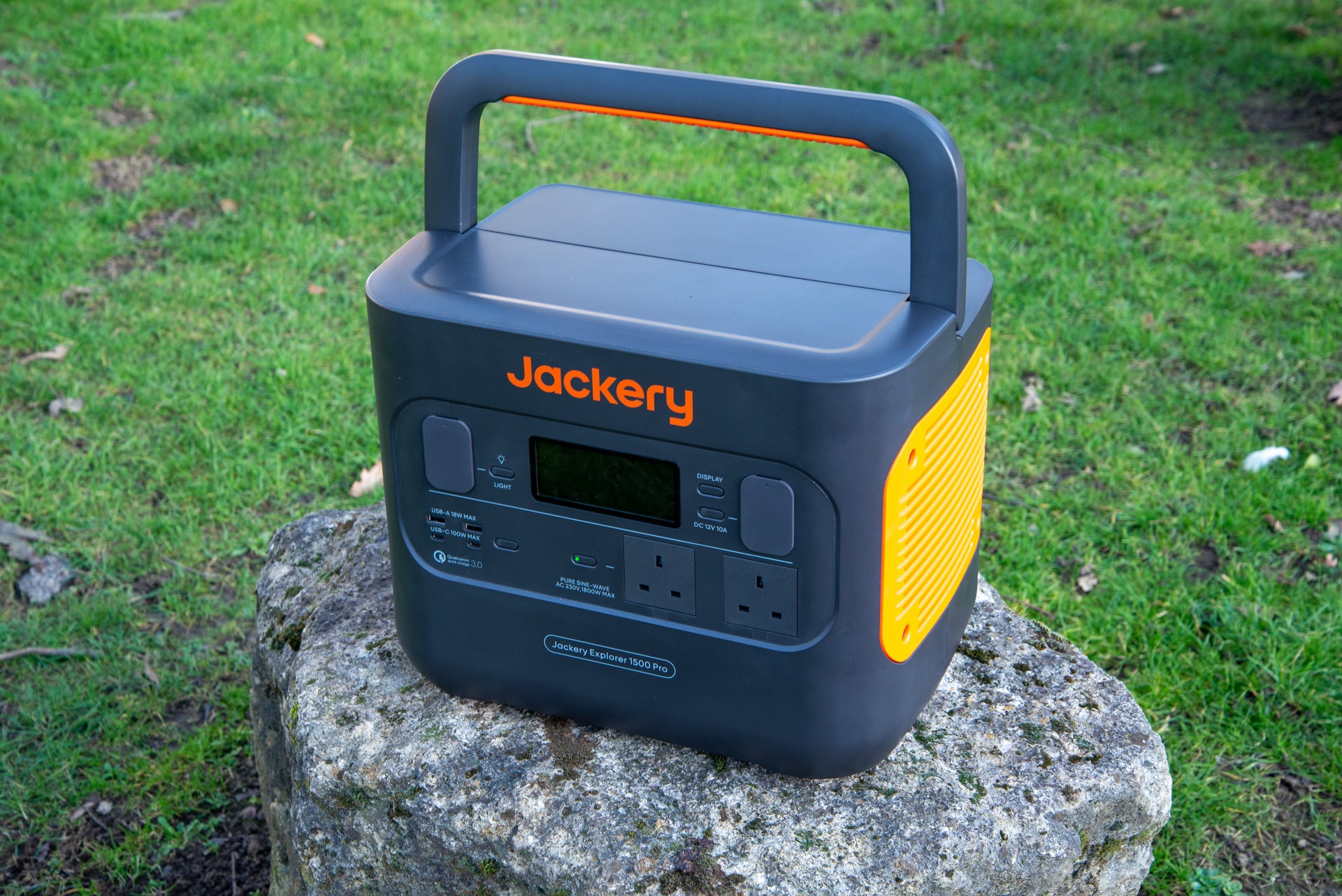Review sản phẩm
Trạm Pin Nhẹ, Dung Lượng Cao – Một Giải Pháp Hấp Dẫn
## Trạm Pin Nhẹ, Dung Lượng Cao – Một Giải Pháp Hấp Dẫn
Mở đầu:
Nhu cầu về các nguồn năng lượng di động, bền vững và hiệu quả đang ngày càng tăng cao trong nhiều lĩnh vực, từ các thiết bị điện tử cá nhân đến các hệ thống năng lượng quy mô lớn. Sự phát triển của công nghệ pin đã dẫn đến sự ra đời của các trạm pin nhẹ, dung lượng cao, hứa hẹn một giải pháp hấp dẫn cho những thách thức năng lượng hiện nay. Bài viết này sẽ phân tích chi tiết về công nghệ này, những ưu điểm, nhược điểm, và tiềm năng ứng dụng của nó.
Công nghệ và cấu tạo:
Trạm pin nhẹ, dung lượng cao thường sử dụng các loại pin tiên tiến như pin Lithium-ion (Li-ion) với mật độ năng lượng cao. Sự cải tiến về vật liệu cathode và anode, cùng với việc tối ưu hóa quá trình sản xuất, đã giúp giảm đáng kể trọng lượng và kích thước của pin mà vẫn đảm bảo dung lượng lưu trữ lớn. Bên cạnh đó, hệ thống quản lý pin (BMS) thông minh đóng vai trò quan trọng trong việc giám sát và điều khiển quá trình sạc, xả, đảm bảo an toàn và kéo dài tuổi thọ của pin. Thiết kế mô đun hóa cho phép tùy chỉnh dung lượng và cấu hình trạm pin theo nhu cầu sử dụng.
Ưu điểm nổi bật:
* Khối lượng nhẹ, kích thước nhỏ gọn: Đây là một trong những ưu điểm vượt trội, giúp dễ dàng vận chuyển và lắp đặt, đặc biệt hữu ích trong các ứng dụng di động hoặc ở những địa điểm khó tiếp cận.
* Dung lượng lớn: Cho phép lưu trữ năng lượng đáng kể, đáp ứng nhu cầu sử dụng lâu dài mà không cần sạc thường xuyên.
* Hiệu suất cao: Công nghệ pin tiên tiến đảm bảo hiệu suất chuyển đổi năng lượng cao, giảm hao phí và tối ưu hóa việc sử dụng năng lượng.
* Tính linh hoạt: Có thể được sử dụng trong nhiều ứng dụng khác nhau, từ cung cấp điện cho thiết bị cá nhân, thiết bị y tế di động đến hỗ trợ năng lượng cho các hoạt động ngoài trời, hoặc như nguồn dự phòng trong trường hợp mất điện.
* Thân thiện với môi trường: Một số loại pin sử dụng trong trạm pin nhẹ có khả năng tái chế, giảm thiểu tác động tiêu cực đến môi trường.
Nhược điểm:
* Giá thành: So với các loại pin truyền thống, giá thành của các loại pin tiên tiến sử dụng trong trạm pin nhẹ có thể cao hơn.
* Tuổi thọ: Mặc dù tuổi thọ pin đã được cải thiện đáng kể, nhưng nó vẫn có giới hạn và cần được thay thế sau một thời gian sử dụng.
* An toàn: Việc sử dụng pin Lithium-ion đòi hỏi các biện pháp an toàn nghiêm ngặt để tránh nguy cơ cháy nổ, đặc biệt trong điều kiện sử dụng khắc nghiệt.
Ứng dụng tiềm năng:
Trạm pin nhẹ, dung lượng cao có tiềm năng ứng dụng rộng rãi trong nhiều lĩnh vực:
* Điện thoại di động, máy tính bảng: Cung cấp thời gian sử dụng lâu hơn.
* Thiết bị y tế di động: Đảm bảo nguồn điện ổn định cho các thiết bị y tế trong các tình huống khẩn cấp.
* Xe điện: Tăng phạm vi hoạt động của xe điện.
* Hệ thống năng lượng mặt trời/gió: Lưu trữ năng lượng tái tạo và cung cấp điện ổn định.
* Ứng dụng quân sự: Cung cấp năng lượng cho các thiết bị quân sự di động.
* Cắm trại, hoạt động ngoài trời: Cung cấp nguồn điện cho các thiết bị điện tử trong các chuyến đi xa.
Kết luận:
Trạm pin nhẹ, dung lượng cao là một giải pháp năng lượng đầy hứa hẹn, đáp ứng nhu cầu ngày càng cao về các nguồn năng lượng di động, bền vững và hiệu quả. Tuy nhiên, việc phát triển công nghệ, giảm giá thành và đảm bảo an toàn vẫn là những thách thức cần được giải quyết để thúc đẩy việc ứng dụng rộng rãi công nghệ này trong tương lai.
#trạm_pin #pin_nhẹ #dung_lượng_cao #năng_lượng_di_động #công_nghệ_pin #pin_lithium_ion #năng_lượng_tái_tạo #hệ_thống_năng_lượng #giải_pháp_năng_lượng #tiến_bộ_công_nghệ
Giới thiệu High capacity, lightweight battery station
Bộ sạc pin nhẹ, dung lượng cao
Queen Mobile đã mang đến cho chúng ta một sản phẩm tuyệt vời – công nghệ pin di động với dung lượng cao và khối lượng nhẹ. #QueenMobile #pin #dungluongcao
Với công nghệ tiên tiến, nhà sản xuất đã tạo ra một pin di động có dung lượng cao, giúp chúng ta dễ dàng sạc lại thiết bị di động của mình mọi lúc, mọi nơi mà không cần lo ngại về việc hết pin giữa chừng. Không chỉ dừng lại ở dung lượng cao, Queen Mobile còn tập trung vào việc làm cho thiết bị của chúng ta trở nên nhẹ nhàng hơn bằng cách sử dụng các vật liệu tiên tiến, giúp giảm trọng lượng và tăng tính di động. #sacpin #diemtosangpin
Với công nghệ này, việc chuẩn bị sẽ không còn là một vấn đề. Ta có thể mang theo pin di động này trong túi xách, balo hoặc thậm chí trong túi quần, mà không phải lo lắng về trọng lượng. Với một pin di động nhẹ nhàng, Queen Mobile mang đến sự thuận tiện đáng kinh ngạc cho người dùng. #thuancong #sohan
Ngoài ra, Queen Mobile cũng thích hợp cho cả những chuyến đi dưới nước. Với khả năng chống nước và chống va đập, ta không cần phải lo lắng về việc pin di động bị hỏng hóc vì một vài tai nạn đáng tiếc. Điều này đặc biệt hữu ích khi ta muốn sạc lại thiết bị trong khi đang tắm biển hoặc khi gió to đang thổi mạnh. Cùng Queen Mobile, không có gì là không thể! #donghoy #chongnuoc #chongvadap
Với giá trị và chất lượng mà Queen Mobile mang lại, việc đánh giá sản phẩm này trở nên dễ dàng hơn bao giờ hết. Chúng ta có thể hoàn toàn tin tưởng vào sự hoạt động ổn định và hiệu suất của nó. Mua ngay sản phẩm này tại Queen Mobile và hãy trải nghiệm sự tiện ích mà nó mang lại! #chatluong #muanhanh #queenmobile
Mua ngay sản phẩm tại Việt Nam:
QUEEN MOBILE chuyên cung cấp điện thoại Iphone, máy tính bảng Ipad, đồng hồ Smartwatch và các phụ kiện APPLE và các giải pháp điện tử và nhà thông minh. Queen Mobile rất hân hạnh được phục vụ quý khách….
_____________________________________________________
Mua #Điện_thoại #iphone #ipad #macbook #samsung #xiaomi #poco #oppo #snapdragon giá tốt, hãy ghé [𝑸𝑼𝑬𝑬𝑵 𝑴𝑶𝑩𝑰𝑳𝑬]
✿ 149 Hòa Bình, phường Hiệp Tân, quận Tân Phú, TP HCM
✿ 402B, Hai Bà Trưng, P Tân Định, Q 1, HCM
✿ 287 đường 3/2 P 10, Q 10, HCM
Hotline (miễn phí) 19003190
Thu cũ đổi mới
Rẻ hơn hoàn tiền
Góp 0%
Thời gian làm việc: 9h – 21h.
KẾT LUẬN
High capacity, lightweight battery station là một dự án mới phát triển nhằm đáp ứng nhu cầu ngày càng tăng của người tiêu dùng về tính di động và năng lượng. Sản phẩm này có khả năng lưu trữ một lượng điện năng lớn và đáp ứng nhu cầu sạc nhanh cho các thiết bị như điện thoại di động, laptop, máy tính bảng và nhiều thiết bị đồng thời khác. Điểm đặc biệt của high capacity, lightweight battery station là trọng lượng nhẹ, giúp người dùng dễ dàng mang theo bất cứ nơi nào mà không gặp khó khăn. Sản phẩm được thiết kế với kích thước nhỏ gọn, tiện lợi và dễ sử dụng. Đồng thời, high capacity, lightweight battery station còn có tính năng bảo vệ quá tải, chống quá nhiệt và chống nước, giúp người dùng yên tâm sử dụng mà không phải lo lắng về an toàn. Với high capacity, lightweight battery station, người mua sẽ có trải nghiệm tuyệt vời về công nghệ năng lượng.
Verdict
It’s compact and looks built to take a few knocks, but the WAI PPS-400 has a limited range of ports, crammed into two small panels. Despite a surprisingly high battery capacity and good discharge efficiency, it’s rather slow to charge and isn’t especially confidence-inspiring to use. Overall, this is a cheap way to buy a mains power bank with a decent capacity, but I’d rather spend a little more on something that feels more dependable.
Pros
- Light and compact for this capacity
- Range of charging options
- Good output efficiency at load
Cons
- Crowded control panel
- Not the best port selection
- Unreliable at higher loads
-
A small-medium power bankThis compact power bank packs a strong 426 watt-hour battery – enough to power a computer for a few hours -
A range of portsPower mains and USB devices through a range of ports – but not the most comprehensive we’ve seen.
Introduction
WAI is best known for its range of car accessories, but its PPS-400 is an all-purpose portable power bank.
It’s compact and light compared to the competition, yet it packs in a 426Wh battery, giving it a bit more oomph than you might expect for its size.
The port selection includes two USB-A and two AC sockets, with the latter capable of supplying 400W between them – that’s a cut above entry-level devices, making this a compelling power bank for the money. However, I found it to be unreliable at higher loads, so it may well be worth spending a little bit more elsewhere.
Design and features
- Light, compact and rugged
- Cramped and unimpressive port selection
- Very basic display
While many portable power supplies look more like a stereo than a battery, the WAI PPS-400 looks like something a mechanic might use to start your car. Indeed, it’s part of the company’s new EV range, which also includes a selection of EV charging cables. I’m not entirely clear how it fits in – it’s far short of the power you’d need to top up an electric vehicle’s battery.
The PPS-400 may look drab, but it’s impressively compact. It’s slightly narrower than a loaf of bread, and weighs only 3.7kg – the same as Anker’s PowerHouse 521, which has only just over half as much battery capacity. On top there’s a retractable handle, but the four long sides are otherwise featureless aluminium – all the important bits are crammed into the two small, square ends.
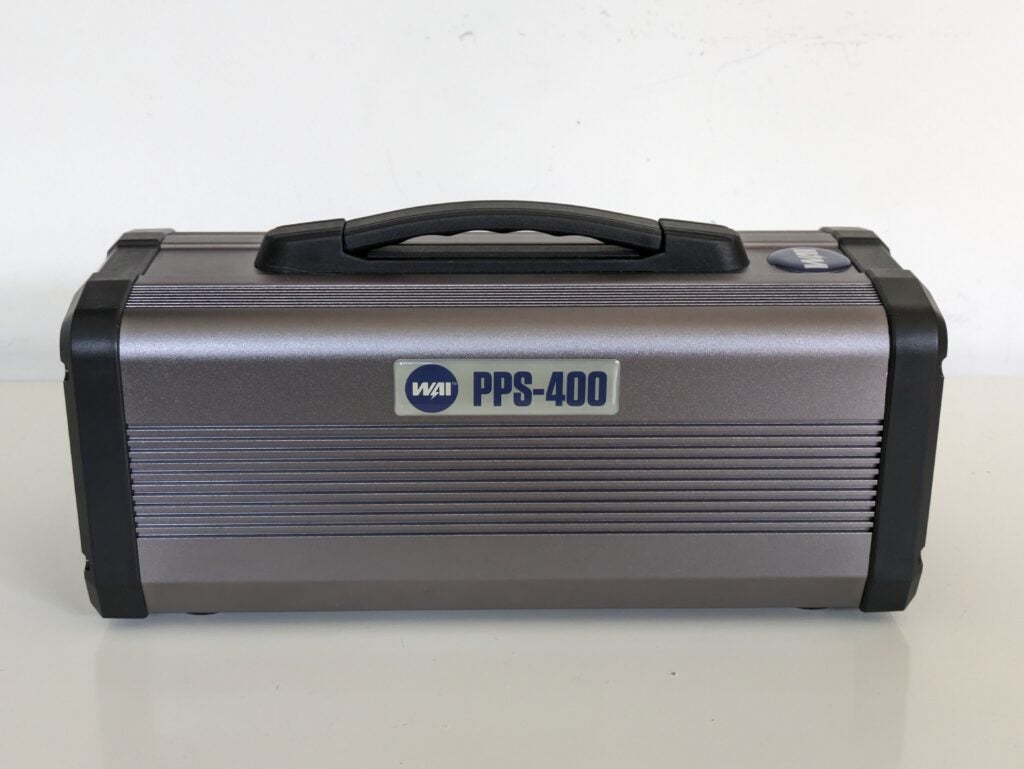

That’s not great. The business end combines AC and solar inputs, a lamp, display, two USB-A ports and two 12V DC ports, alongside switches for the lamp, DC and AC ports. Add in fresh air vents and it’s a cramped space with a fairly arbitrary layout.
The light is bright and directional, which is great for finding your way, but less so for reading in a tent at night. The switches operate with a pleasant click, and the plastics seem strong.
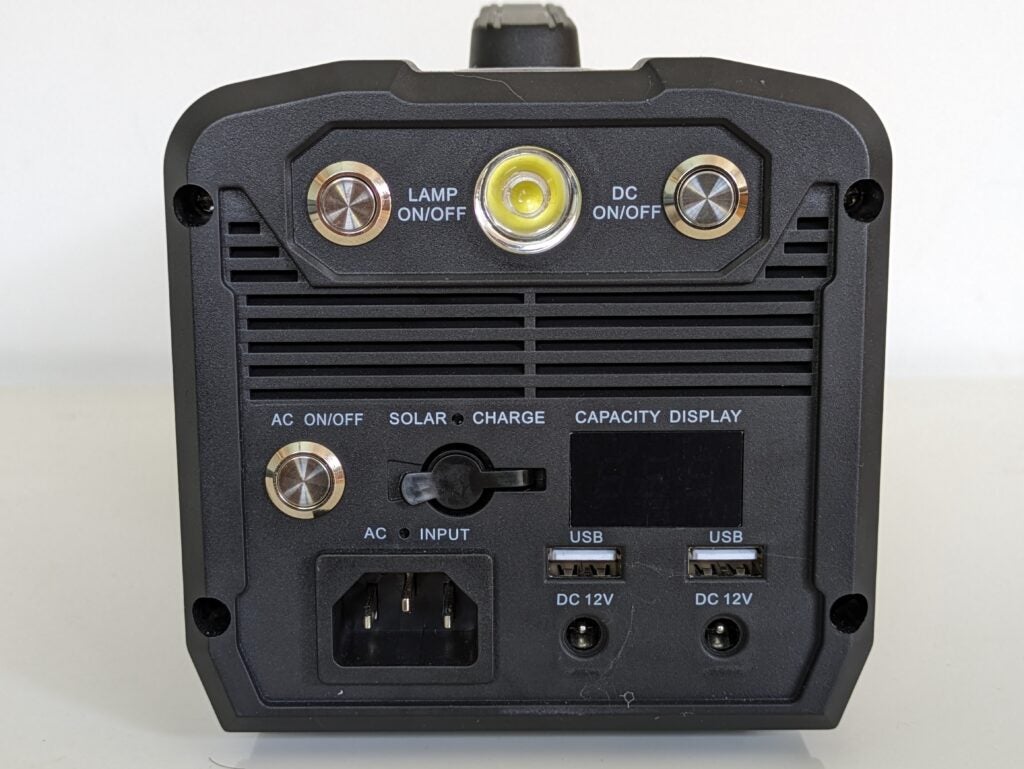

At the back end are two AC ports, plus fans for active cooling.
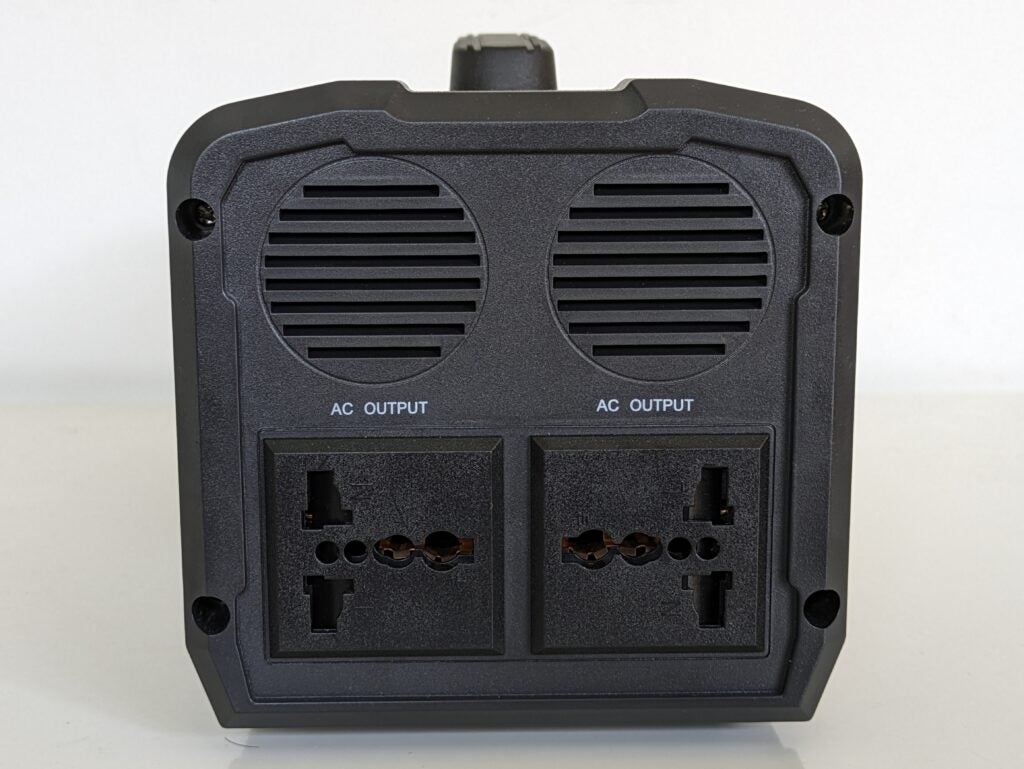

Here, the small panel poses another problem: the ports are arranged horizontally and orientated 180 degrees from each other. Some top-heavy power adaptors won’t fit without blocking the second port, while regular power plugs are close to the edge of the device.
This means cables project from the side, with little ability to flex if they’re knocked. In combination with the loose-fitting multi-region sockets, it’s too easy to knock a plug loose.
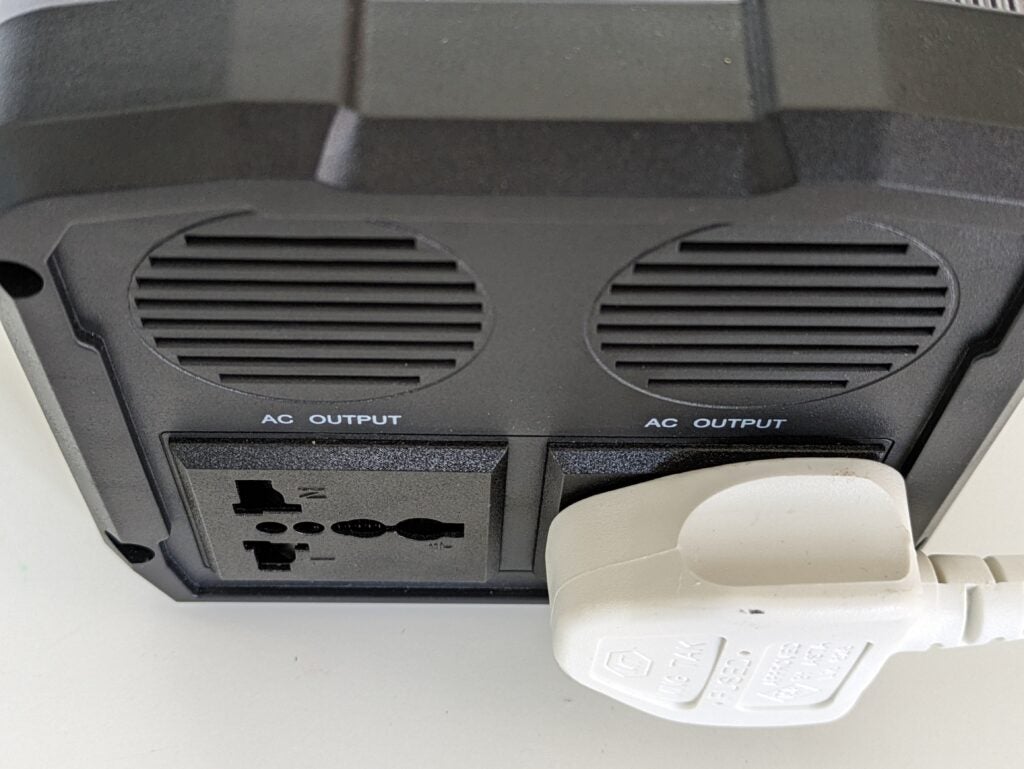

The WAI PPS-400 has a very basic display, showing only the battery charge percentage. It’s off unless you turn on the DC or AC circuits, and doesn’t provide any indication of incoming or outgoing power, or how long the battery will take to charge or drain.
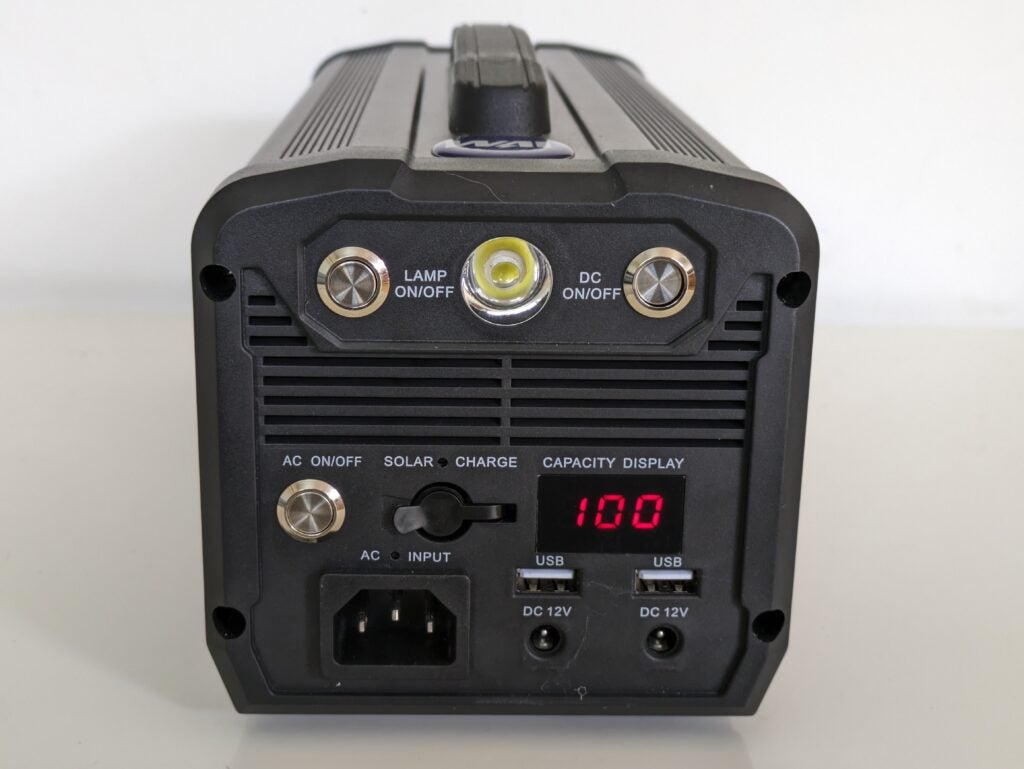

It’s a shame WAI hasn’t found room for any USB-C ports, or a car output. The USB ports can provide 15W each, while the DC outputs are good for a combined 120W maximum.
Charging
- Charge from mains, car or the sun
- Maximum 70W input
- Charges slowly, but can charge and provide power
This isn’t the fastest charging power bank, but it is fairly flexible. Connected to a mains input it’ll charge at about 55 watts, meaning it should need around eight hours to reach full charge. Alternatively, you can use the supplied cable to charge from a car power supply at a maximum 70W, meaning you could be fully recharged after around six hours of driving. A final option lets you connect up to 70W of solar power, but this is limited to a maximum 18V input. The PPS-400 doesn’t come with panels and I didn’t have suitable ones, so I couldn’t test this function.
WAI’s manual says that this power bank’s charge light turns from red to green when it’s fully charged. It also says that the display will show 100% charge when the battery reaches 90%. In practice it wasn’t clear when it was fully charged – the charge light never turned green, and even after more than 12 hours the PPS-400 was still consuming around 6W with all its circuits off.
After fully depleting it again, I watched the figures more closely. The display reported 44% charge after my meter reported it had drawn only 87Wh – about a fifth of the battery capacity. When the display first reached 100%, my meter reported only 275Wh (65%) consumed, and that the power bank was still drawing 60W. After around 13 hours it had consumed 507Wh, but still didn’t quite seem full.
This vague and seemingly inaccurate capacity reporting seems a bit unusual by today’s standards. I couldn’t be sure that the battery was fully charged but, even assuming it was, my measurements suggest a charge efficiency of 84%, which is a little low. I should also mention that the cooling fans cut in and out during charging, and while they’re not loud, their small diameter means they’re a bit harsh.
The WAI PPS-400 is equipped with a bypass circuit, meaning that when it’s connected to the mains it can supply mains power without first having to convert it to direct current and back. This lets it power mains devices without slowing down charging. Its AC input is rated at three amps, meaning that in theory it could provide around 650W to plugged in devices while charging the battery. I tested it with my microwave on its lowest power setting, which demands between 60-650W, and it coped fine.
The bypass circuit means the PPS-400 needs to switch over to battery power if there’s a blackout. WAI says it can do this in less than 10 milliseconds, and it was certainly fast enough to switch without causing my office equipment any problems. At an indicated 20% the display starts flashing to warn you that the battery is getting low, and at 0% it starts a very loud intermittent beep. While that’s good if you want time to shut down your devices, this phase lasted for 35 minutes in my low-load test, and there’s no button to silence it.
Performance
- Unreliable power output
- Good discharge efficiency on heavy loads
In theory, this power supply’s moderate capacity makes it a good choice for light backup duties in the home. For example, it could potentially power my internet router and network storage (NAS) drive for about seven or eight hours – ideal for riding out a significant blackout. I tested it by connecting up an air purifier, drawing around 32W. It lasted for eight hours, supplying a total of 240Wh according to my power meter.
Assuming the battery began with a full charge, that’s a low discharge efficiency of 56%. That’s not unusual for light-load testing, however, where consumption by the power bank’s own AC inverter has quite an impact over several hours.
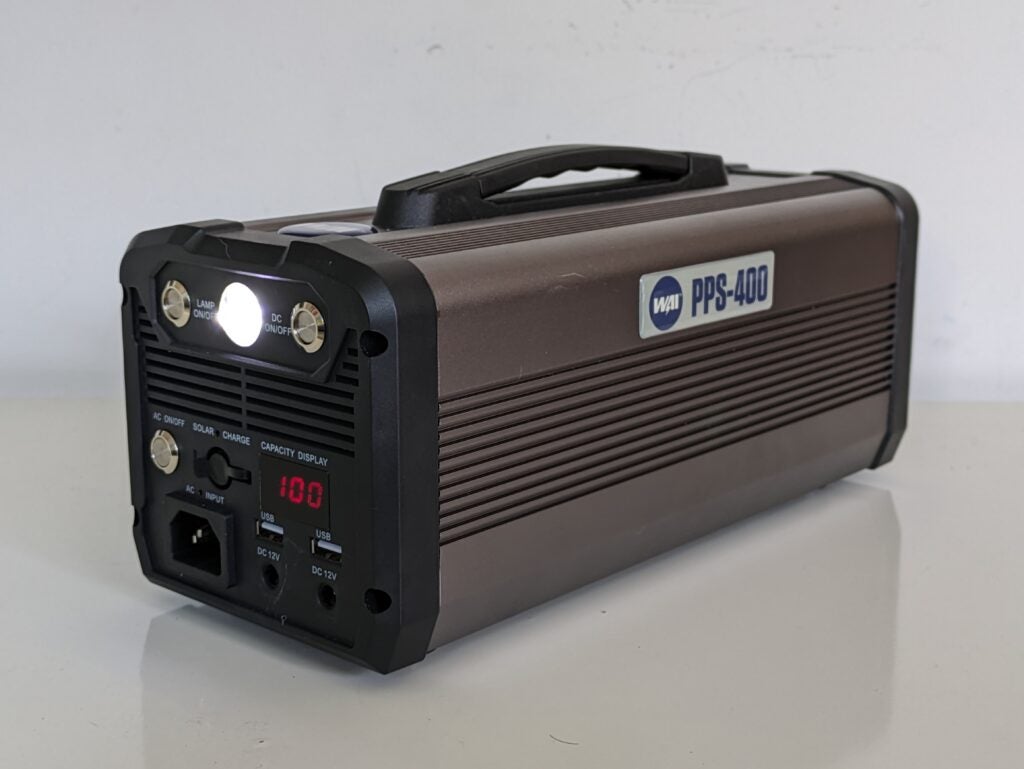

I tested the PPS-400 with a more demanding setup drawing around 220W, which is well within the range of its stated 400W AC output. It started off quite comfortably, with the fans occasionally kicking in, before it cut out after about ten minutes. It reset automatically and continued for a couple of minutes before the fans cut in again, and about 10 seconds later it reset. I watched it repeat this cycle a few times, keeping a close eye on the maximum power demand as reported by my power meter – it didn’t exceed 220W.
I reconfigured the test to reduce the demand to 190W, which proved stable. If I tried increasing it back to 220W the PPS-400 would fall over within just a couple of minutes.
Tested from full to empty with a 190W load, the WAI PPS-400 lasted about an hour and three quarters, supplying a total of 328Wh. That equates to a much more impressive discharge efficiency of 77%. Unfortunately, even using this the best round-trip efficiency (charge and discharge) worked out at 65% – meaning about a third of the electricity used to charge it was lost.
I repeated my low-power microwave test with the PPS-400 operating on battery power. It coped for a few seconds, but the moment the power demand spiked towards the 650W maximum it shut down. This is safe and quite reasonable, bearing in mind I was testing it well beyond its stated 400W output power.
While more expensive power supplies use LFP batteries of the type found in electric cars, the WAI PPS-400 uses standard lithium-ion (Li-ion) cells, which have a shorter working life of around 800 cycles, compared to typically 3,000 for LFP. Calculated based on an 80% charge, this power bank might store about 273kWh over its lifetime. That gives an overall price per kilowatt hour of £1.10, around three times what you might expect from more durable cells.
Latest deals
Should you buy it?
You want high capacity at a low price: This provides a good battery capacity for the money
You need more power output: This battery station wasn’t fully reliable in my tests
Final Thoughts
On paper this ought to be a decent power bank, but in tests the WAI PPS-400 was disappointing. It was slow and comparatively inefficient to charge, and its basic display seemed approximate. More importantly, it wasn’t stable when supplying well within its rated power, which didn’t fill me with confidence about its quality.
Based on my experience, it might not prove reliable in situations when it should be. It might be good value for use with low loads, but I’d be inclined to pay more for something more robust, such as the Bluetti AC60 or, if you need a lot more power, the Dabbsson DBS2300.
How we test
We test every battery station we review thoroughly over an extended period of time. We use standard tests to compare features properly. We’ll always tell you what we find. We never, ever, accept money to review a product.
Find out more about how we test in our ethics policy.
We test with a variety of devices to see how long the battery will last.
We test different charging methods to see how quickly the battery can be topped up.
You might like…
FAQs
Is this suitable for powering a CPAP device?
On paper, the WAI PPS-400 should be suitable, but my experience with it resetting means I can’t recommend it for critical medical applications.
How portable is this power bank?
It’s extremely portable. It’s lightweight given its battery capacity, and compact enough to sneak into a full car boot.
Trusted Reviews test data
‹
UK RRP
USA RRP
EU RRP
CA RRP
AUD RRP
Quiet Mark Accredited
Battery
Size (Dimensions)
Weight
Release Date
First Reviewed Date
Model Number
Battery type
Battery technology
Battery size
WAI PPS-400
£300
Unavailable
Unavailable
Unavailable
Unavailable
No
426 Whr
122 x 293 x 130 MM
3.8 KG
2023
21/06/2023
PPS-400
Rechargeable
Lithium-ion
AA
›
Xem chi tiết và đăng kýXem chi tiết và đăng kýXem chi tiết và đăng ký
Khám phá thêm từ Phụ Kiện Đỉnh
Đăng ký để nhận các bài đăng mới nhất được gửi đến email của bạn.


